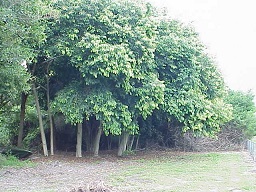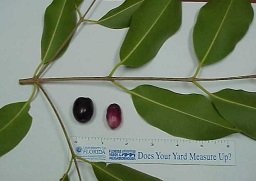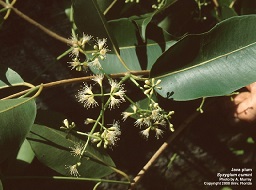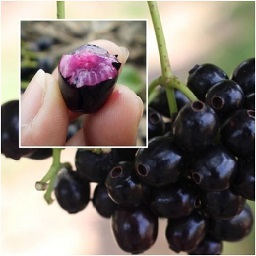Article
from Okeechobee News
by Dan Culbert - Okeechobee County Extension Horticulture Agent, Retired
Java Plum
An office visitor once sent me a photo a large
tree that had
taken over her new Okeechobee homestead. While cleaning
“Florida holly” trees (a.k.a. Brazilian Peppertrees), they
found a bunch of other rapidly growing trees with a fruit that tastes
similar to a grape, with a dark purple covering and white meat
inside. The trees were loaded with this fruit. They wanted
to know what it was, and if the fruit was safe to eat.

Fig. 1 
Cluster of Java Plum Trees
Having
seen this plant in my West Palm Beach yard several years ago, I
recognized it as an exotic tree known as the Java Plum. Among its many
names are Jambolan, Jambu and many other names that include
‘plum’. (Botanically it is known as Syzygium cumini).
The
java plum is fast-growing, reaching full size in 40 years. It ranges up
to 40 or 50 ft tall in Florida; and it may attain a spread of 36 ft
with a trunk diameter of 2 or 3 ft. It usually forks into
multiple trunks a short distance from the ground. The bark on the lower
part of the tree is rough, cracked, flaking and discolored; further up
it is smooth and light-gray.
The turpentine-scented evergreen
leaves are opposite, 2 to 10 in. long, 1 to 4 in. wide; oblong-oval or
elliptic, blunt or tapering to a point at the apex; pinkish when young;
when mature, leathery, glossy, dark-green above, lighter beneath, with
conspicuous, yellowish midrib.

Fig. 2 
Foliage and fruit

Fig. 3 
Flowers
The
fragrant flowers, in 1-to 4-in clusters, are 1/2 in wide, 1 in
(2.5 cm) or more in length; have a funnel-shaped calyx and 4 to 5
united petals, white at first, then rose-pink, quickly shed leaving
only the numerous stamens. These are typical flower forms for the
Myrtle family.
The fruit, in clusters of just a few or 10 to 40,
is round or oblong, often curved; 1/2 to 2 in. (1.25-5 m) long, and
usually turns from green to light-magenta, then dark-purple or nearly
black as it ripens. (A white-fruited form has been reported in
Indonesia.) The skin is thin, smooth, glossy, and adherent. The pulp is
purple or white, very juicy, and normally encloses a single, oblong,
green or brown seed, up to 1½ in. in length. The fruit is
usually astringent, sometimes unpalatably so, and the flavor varies
from acid to fairly sweet. The main fruiting season in India
and
southern Florida (where the tree blooms principally in February and
March) extends through late May, June and July. Small second crops from
late blooms have been observed in October. Individual trees may
habitually bear later than others.
 s s
Fig. 4 
Fruit, showing interior and cluster
Jambolan
fruit of good size and quality, having a sweet or subacid flavor and a
minimum of astringency, are eaten raw and may be made into tarts,
sauces and jam. I have also been contacted by persons in the US that
are native to southern Asia that appreciate this fruit from their
native countries. They have said they are willing to have it
shipped to them; however, this violates weed laws and it is doubtful
the fruit would hold up to the rigors of modern package delivery
services.
The jambolan is native in India, Burma, Ceylon and the
Andaman Islands. It was long ago introduced into and became naturalized
in Malaya. In southern Asia, the tree is venerated by Buddhists, and it
is commonly planted near Hindu temples. Java Plum fruit has
been
made into wine, vinegar. In some areas it is a valuable “nectar
tree” for honeybees. Because of its fast growth rates,
considerable wood can be produced in a few years. Jambolan
lumber
is used for industrial purposes such as crates and posts; in rural
areas it has been used as a windbreak, and resistant to coastal high
winds, but not to heavy salt spray.
In 1911 the USDA Bureau of
Plant Industry received jambolan seeds from the Far East. The tree
flourished in Santa Barbara California, although fruit production is
poor in that climate. In southern Florida, the tree was rather
commonly planted in the past. Heavy fruit crops may litter streets,
sidewalks and lawns, attracting insects, rapidly fermenting and
creating a foul atmosphere. Most Floridians are eager to have the trees
cut down. Where conditions favor spontaneous growth, the seedlings
become a nuisance, as well.
Seed lose their viability rapidly,
and vegetative propagation by cuttings and grafting has been used with
this plant. In the wild, seeds contained in the fruit are spread by
birds and mammals, including raccoons and wild hogs. (In Hawaii, mynah
birds are the primary transportation means for the java plum.)
The
jambolan has received far more recognition in folk medicine and in the
pharmaceutical trade than in any other field. Preparations of
fruit, leaves, bark and seed have been suggested to be effective for
various ailments – but reliable medical research on these uses is
not well reported in the scientific literature.
My office caller
reported that these java plums have created a small forest of their
own, growing on the bank of the canal and crossing over to another
piece of property. Once recommended as a shade tree, it has been
considered naturalized in southern Florida since 1982, forming dense
canopies that shade out young native trees in wet pinelands, hammocks,
and well drained uplands.
|
|
Bibliography
Culbert, Daniel F. “Java
Plum.” Feature Article
for Okeechobee News, August 4, 2004, 2018, UF/IFAS, Okeechobee
County Extension Service, okeechobee.ifas.ufl.edu.
Morton, J. "Jambolan." Fruits
of warm climates, Winterville, N.C Creative Resource
Systems, 1987, newcrop.hort.purdue.edu/newcrop/morton/jambolan.html.
Langeland, K., and Berks. "Identification of Invasive Plants." Gainesville: UF/IFAS Extension
Service. plants.ifas.ufl.edu/syzcum.pdf.
Photographs
Fig. 1 Culbert, D. F. "Cluster of Java
Plum Trees growing in Okeechobee FL."
UF/IFAS, Okeechobee
County Extension Service, okeechobee.ifas.ufl.edu.
Fig. 2 Culbert, D. F. " Leaves and
fruit of Jambolan." UF/IFAS, Okeechobee
County Extension Service, okeechobee.ifas.ufl.edu.
Fig. 3 Murray, Anne. "Flowers." UF/IFAS Center for Aquatic and
Invasive Plants assessment, assessment.ifas.ufl.edu/assessments/syzygium-cumini/.
Fig. 4 "Fruit, showing interior and cluster."
Australian Rare
Fruit Review, plant.daleysfruit.com.au/l/jambolan-plum-syzygium-cumini-14173.jpeg.
Accessed 1 June 2018.
Published 3 June 2018 LR
|




 s
s